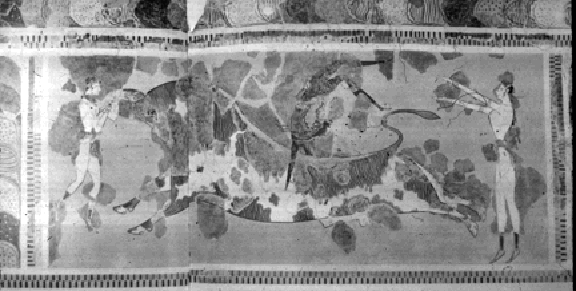|
|
![]()

"Bull Leaping" fresco from Minoan
palace at Knossos, c. 3000-1450 BC. Lyrical, free form Minoan art depicts an
acrobatic dance performed with a live bull. Archaeologists believe this to have
been a common form of popular entertainment.

Dendra Panoply, Bronze panoply of armor found in Mycenaean
warrior’s grave at Dendra, near Mycenae, c. 1200 BC. Panneled armor permitted Mycenaean warriors to engage in
combat, as described by Homer. Moreover, boar’s-tusk helmet likewise confirms
Homeric tradition for Mycenaean warriors constructing their helmets from
hunting trophies.

STRATIGRAPHY AT TROY The site of Hisarlık is
renowned for its association with Homer's Iliad and the tradition for the Trojan
War. The site is situated on the northwest coast of modern
Turkey (Anatolia) on a fertile plain at the southern entrance to the Dardanelles
(the ancient Hellespont). For millennia the Hellespont served as the chief shipping
lane between the ancient urban civilizations of the Aegean and the grain-producing
region of the northern Black Sea Coast (modern day Ukraine). The presence of arable
land, potable water, and a strategic waterway caused this location to be occupied repeatedly during the course of the ancient experience.
Initially excavated in the 1860s by Heinrich Schliemann and continuing under archaeological
investigation by German, Turkish, American teams to this day, the site, abandoned
since antiquity, exhibits twelve identified levels of human habitation. Based on
the presence of Mycenaean pottery and inscribed Egyptian scarabs, the level that
conforms most to the Trojan War era (c. 1250-1220 BC) is generally
recognized to be that of Troy level VIIa.
[The link bar feature is not available in this web]